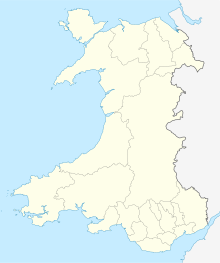Aberporth Airport (ICAO: EGFA) (Welsh: Maes Awyr Aber-porth) is situated southwest of Aberporth, Ceredigion, Wales. The airport is being developed as West Wales Airport for domestic flights.[2] It is also developing as a centre for the deployment of civil and military unmanned aerial vehicles (UAVs), known as 'drones'. The airport underwent major improvements in 2008 which extended the length of the runway from 945 to 1,257 m (3,100 to 4,124 ft).
West Wales Airport West Wales/Aberporth Airport | |||||||||||
|---|---|---|---|---|---|---|---|---|---|---|---|
| Summary | |||||||||||
| Airport type | Public | ||||||||||
| Operator | West Wales Airport Ltd. | ||||||||||
| Serves | Cardigan | ||||||||||
| Location | Aberporth | ||||||||||
| Elevation AMSL | 428 ft / 130 m | ||||||||||
| Coordinates | 52°06′53″N 004°33′34″W / 52.11472°N 4.55944°W | ||||||||||
| Map | |||||||||||
| Runways | |||||||||||
| |||||||||||
The site was previously RAF Aberporth, a former Royal Air Force satellite station which used by the RAF Army Cooperation Command, the site was also used the Royal Aircraft Establishment (RAE), the Defence Research Agency (DRA) and the Defence Evaluation and Research Agency (DERA) under the control of the Ministry of Defence until 2001.
During 1956, a brand-new asphalt runway was built, with other extensions of the hangar apron occurring during 1968 and 1971.[3]
During the 1960s Aberporth was the HQ of the RAE Ranges Division.[4]
History
RAF Aberporth 1940-46 & 1959-84
The following military units were posted here at some point:
- 'B' Flight of No. 1 Anti-Aircraft Co-operation Unit RAF (1 AACU) (October 1941 - March 1942)[5]
- 'L' Flight of 1 AACU (October 1941 - November 1942)[6] became No. 1608 (Anti-Aircraft Co-operation) Flight RAF (November 1942 - December 1943)[7]
- Detachment of 'O' Flight of 1 AACU (May - June 1942)[6]
- 'Q' Flight of 1 AACU (June 1941 - November 1942)[6] became No. 1609 (Anti-Aircraft Co-operation) Flight RAF (November 1942 - December 1943)[7]
- 'X' Flight of 1 AACU (September 1940 - November 1942)[6] became No. 1621 (Anti-Aircraft Co-operation) Flight RAF (November 1942 - December 1943)[7]
- Detachment of No. 6 Anti-Aircraft Co-operation Unit RAF (January - May 1941)[6]
- Detachment of No. 6 Air Observers School RAF (June 1942 - January 1943)[8]
- Detachment of No. 7 Anti-Aircraft Co-operation Unit RAF (May 1941 - January 1942)[6]
- Sub site of No. 7 Maintenance Unit RAF (1940)[9]
- No. 595 Squadron RAF (December 1943 - April 1946)[10]
- Detachment of No. 2758 Squadron RAF Regiment[12] (9 September 1942-)[13]
- Detachment of University of Wales Air Squadron[14]
- Aberporth Station Flight (de Havilland Tiger Moth, Hawker Hurricane IV, Avro Anson C.19 & de Havilland Canada DHC-1 Chipmunk T.10)[15]
- No. 29 Joint Services Trials Unit (September 1980 - June 1982) (Sea Skua)[16]
- No. 1 Light Anti-Aircraft Practice Camp[17]
- No. 1 Heavy Anti-Aircraft Practice Camp[17]
RAE Aberporth 1939-73
The following units were posted here at some point:
- Bloodhound (Mk.2) Firing Unit with the Bristol Bloodhound Surface-to-air missile (November 1964 - December 1975)[18]
- Guided Weapons Range Unit (July 1958 - March 1965)[19]
- Operations and Engineering Wings of No. 21 Joint Services Trials Unit (July 1970 - ?) (BAe Rapier)[16]
- No. 23 Joint Services Trials Unit (October 1971 - January 1973) (BAe Rapier)[16]
- RAF Unit (Ministry of Supply) Aberporth (August 1953 - June 1958)[20]
- Central Timing Unit[21]
- Guided Weapons Trials Wing, RAE Aberporth[22]
Polish Army Resettlement Corps Depot 1946-50
The airfield was used as a Polish Army Resettlement Corps Depot between 1946 and 1950.[23]
MOD Aberporth
The nearby range, MoD Aberporth started out as a Second World War British Army firing range. Due to the threat of Nazi Germany invasion, the Projectile Development Establishment moved from Fort Halstead to the range during 1940, with the Royal Air Force Combined Services Projectile Development Establishment being in existence between September 1943 and January 1945.[24] With the site being an outstation of PDE Fort Halstead and Royal Arsenal Woolwich.
The range was previously the Aberporth Anti-Aircraft Artillery Range and the Projectile Development Range[25] along with The Aberporth Range.[26] The Clausen Rolling Platform was built there to test radar and launchers against the rolling motion of ships at sea, without needing to go to sea.
It is used for testing rockets by the British military, as well as for launching civilian rockets for atmospheric research. The site is currently managed by QinetiQ[27] with air traffic services provided by NATS.[28]
Current use
The airport is mainly used for testing unmanned aerial vehicles in a area called the West Wales UAV Centre which is connected to the Welsh Government created ParcAberporth.
No. 636 Volunteer Gliding Squadron RAF was present between October 1996 and December 2001[29]
Aberporth Aerodrome has a CAA Ordinary Licence (Number P859) that allows flights for the public transport of passengers or for flying instruction as authorised by the licensee. The aerodrome is not licensed for night use.[30]
The airfield is being used as a base for Thales Watchkeeper WK450 military unmanned aerial vehicle (UAV) trials over Cardigan Bay. On 13 June 2018 a Watchkeeper crashed into a lane near the airfield; there were no injuries.[31][32]
See also
References
Citations
Bibliography
- Delve, Ken (2007). The Military Airfields of Britain - Wales and West Midlands. Marlborough, UK: Crowood Press. ISBN 978-1-86126-917-1.
- Jefford, C. G. (1988). RAF Squadrons. A comprehensive record of the movement and equipment of all RAF squadrons and their antecedents since 1912. Shrewsbury, UK: Airlife. ISBN 1-85310-053-6.
- Jones, Ivor (2007). Airfields and Landing Grounds of Wales: West. Stroud, UK: Tempus Publishing. ISBN 978-0-7524-4418-5.
- Phillips, Alan (2006). Military Airfields of Wales. Wrexham, UK: Bridge Books. ISBN 1-84494-019-5.
- Sturtivant, Ray; Hamlin, John (2007). Royal Air Force flying training and support units since 1912. UK: Air-Britain (Historians). ISBN 978-0851-3036-59.
